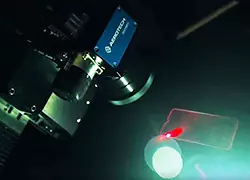What Are The Different Types Of Servo Amplifiers?
A servo amplifier, or servo drive, is the indispensable power electronics device that converts low-voltage command signals into the high-current flow...
Work with our team to determine which products or systems are the best fit for your application.
Some Aerotech products are available for immediate order in North America through our partner Motion Plus.

A case study examining display production that optimizes quality and throughput – and lower total cost.
The fundamental principle of a servo motor is closed-loop feedback control. This mechanism allows the motor system to continuously measure its actual state (position, velocity or torque) and compare it against the desired command. This constant self-correction ensures the motor can precisely reach and dynamically maintain a specific position or speed, actively rejecting external forces or disturbances that would otherwise cause error. This sophisticated functionality relies on precision servo drives to execute the real-time commands and is the core requirement for achieving precision motion control.
A servo motor operates on the principle of feedback control, providing deterministic and precise control of its angular or linear position. The system functions as a robust closed-loop system designed for high fidelity performance.
The servo motor working principle centers on a rapid cycle:
Command: The motion controller sends a digital command (the desired state) to the servo drive.
Actuation: The drive amplifies the command into electrical current, energizing the motor to move.
Feedback: An encoder or sensor reports the motor's actual position and velocity back to the controller/drive.
Correction (Error Calculation): The controller calculates the "error signal" (the difference between desired and actual position) and instantly sends a correctional command to the drive.
This continuous process adjusts the motor's output based on the input signal to quickly reject external disturbances (like load variations or friction changes), ensuring the system maintains precise performance and stability.
In simple language, a servo motor is a motor paired with a specialized sensor and control electronics that can move to a specific position and hold it there actively. Imagine holding a heavy object perfectly still: your brain is the controller, your muscles are the motor and your eyes and nerves provide the feedback to correct the slightest tremor.
The key is that the motor is always "aware" of its exact position through the built-in sensor (the feedback device). If an external force tries to push the motor out of position, the sensor immediately detects the change and the control electronics instantly apply counter-torque to maintain the set point.
This capability makes servo motors ideal for systems requiring high accuracy and dynamic response. While many types of servo motors exist (e.g., rotary, linear, AC, DC), they all share this core closed-loop architecture. The combination of power, precision and active holding capability makes them essential across industrial and precision automation applications.
What is the main function of a servo?
The main function of a servo is to provide precise, dynamic control of movement and positioning. Unlike traditional motors that might only control speed or run until a limit switch is hit, the servo system’s function is to achieve a controlled state (position, velocity or torque) and maintain it against external forces.
Servos are essential in applications requiring accurate control, where positional error can be measured in microns or nanometers. This demanding servo motor application space includes laser cutting, high-speed pick-and-place, micromachining and semiconductor processing. For example, a servo system ensures the laser tool remains perfectly perpendicular and follows an exact contour at a high, constant velocity. By actively correcting errors in real-time, the servo ensures the geometric integrity of the final part. Open-loop systems cannot achieve this level of control.
A servo drive controls the motion of a servo motor by acting as the power interface and execution stage for the servo system. It performs three critical, interlinked functions:
Current Regulation: It executes the fastest control loop—the current (torque) loop—ensuring the motor receives the exact current commanded by the position/velocity loops.
Real-Time Correction: It processes feedback data to adjust the current using closed-loop control, ensuring accurate positioning even in the presence of external disturbances.
The drive is crucial for tuning the motor's dynamic response to a mechanical load such as a linear stage. By managing the current precisely, the drive allows the motor to maintain its commanded position with high fidelity.
Have questions about precision motion control? Ask our experts!
A servo amplifier, or servo drive, is the indispensable power electronics device that converts low-voltage command signals into the high-current flow...
Precision Motion Controller A precision motion controller is the central computing engine designed specifically to meet the stringent demands of...
The core difference between a Programmable Logic Controller (PLC) and a motion controller lies in their primary function, computational focus and...